Drawings of Hands Holding a Pencil
Learning how to draw hands is one of the most important things you can do if you want to be a good figurative artist. But why are they so difficult to get right?
And what if there was a simple way to draw hands that didn't involve years of study and piles of textbooks?
Relax. After reading this article, you'll have a much better understanding of how the hand is constructed and how to draw it.
You don't have to get baffled by science or learn lots of complicated terms that are as difficult to pronounce as they are to remember.
This article will show you how to:
- Easily draw the hand from any angle
- Draw realistic-looking crease lines
- Draw a hand holding different objects
- Break the hand down into simple shapes that anyone can draw
So, are you ready to learn how to draw hands without the hassle?
All you need is a pencil and some paper to get started.
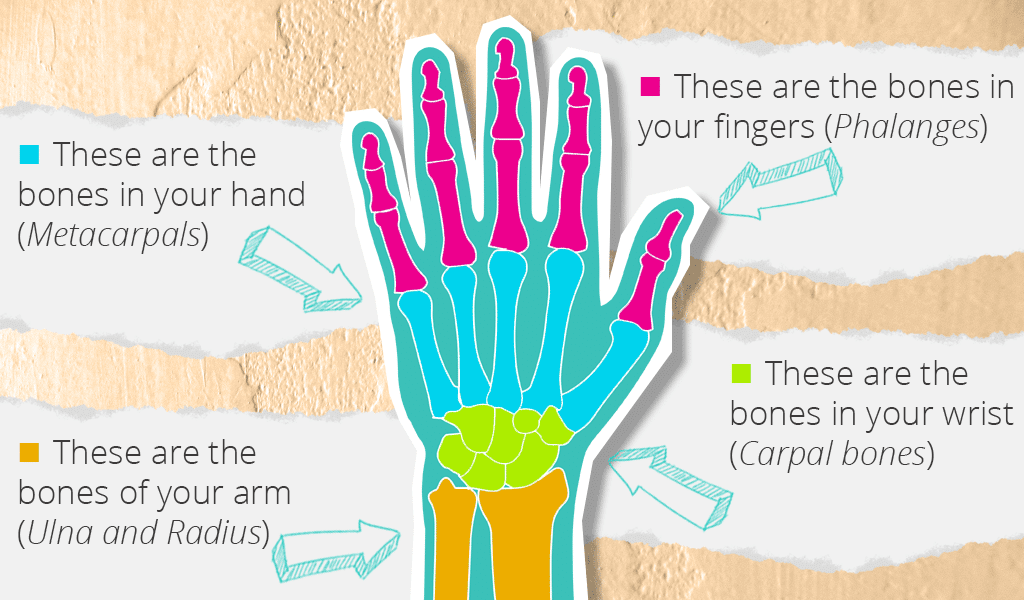
How to Draw Hands: Basic Anatomy
Here's a diagram of the bone structure in the hand. As you can see, the hand is basically made up of four different groups of bones:
- The bones in your fingers and thumb (medical term: Phalanges)
- The bones in your hand (medical term: Metacarpals)
- The bones in your wrist (medical term: Carpal bones), and
- The bones of your arm which the hand is attached to
(medical term: the Ulna and Radius)
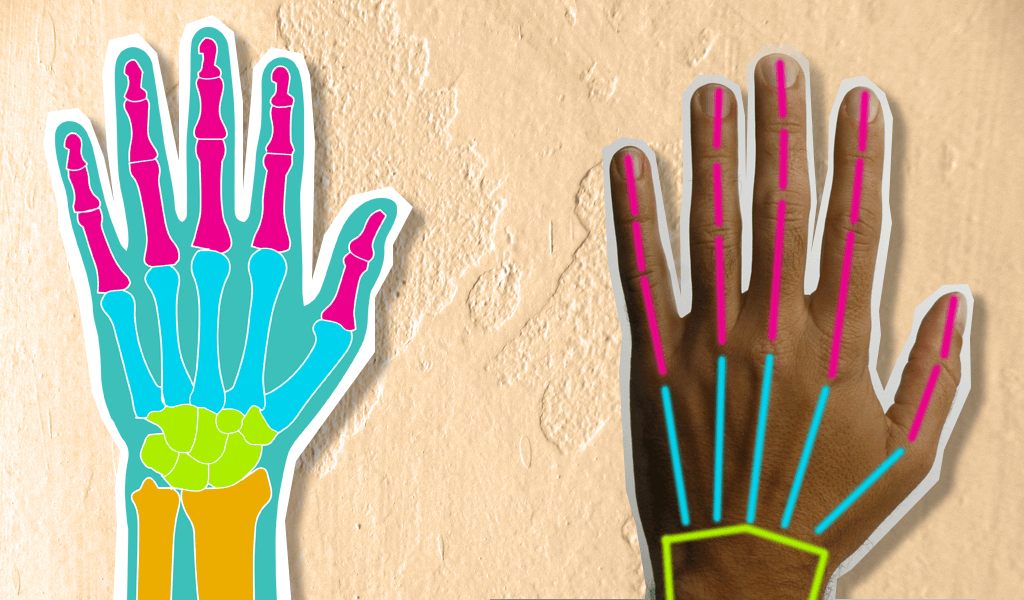
How to Draw Hands: Getting Started With Simple Shapes
Now, let's take a look at how this diagram relates to a real hand. The colored lines on the image of the real hand are color-coded with the bones of the hand in the diagram.
Now you know how the hand is constructed, let's get started with some basic shapes and proportions which will help you draw it more easily.
For this first exercise, you'll be drawing the palm side of the hand.
1. Drawing the Palm of the Hand
The simplest way to draw the palm of the hand is to draw a shape like this, which is basically a rectangle with rounded edges:
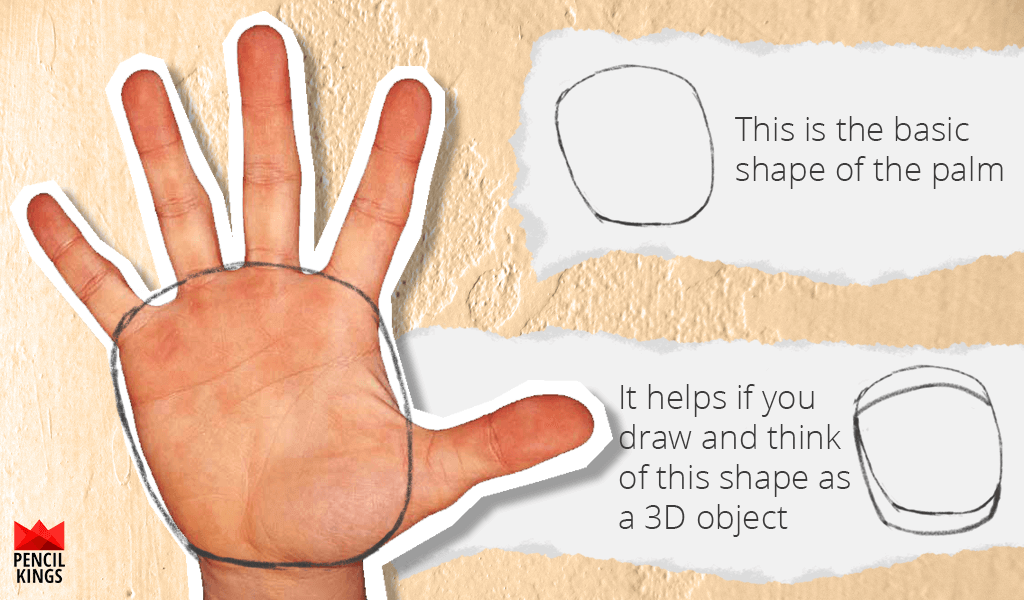
If it helps, imagine this as being similar to the shape of a steak (or a nut cutlet if you're vegetarian!) Also, because this 'steak' shape isn't completely flat, you'll need to draw it with some depth like in the illustration.
Drawing and thinking of this shape as a 3D object will help you when you come to add the fingers and will stop your drawing from looking too flat.
Using the illustration as your reference, practice drawing this shape as many times as you like until you fully understand it.
Once you feel totally confident with drawing this shape, you'll be ready to move onto the next part of learning how to draw hands.
2. Drawing the Fingers and Thumbs
Once you've drawn your basic shape for the palm, it's time to move on to the fingers. Let's look at the basic proportions of the hand first, because this will help you draw the fingers at the correct size:
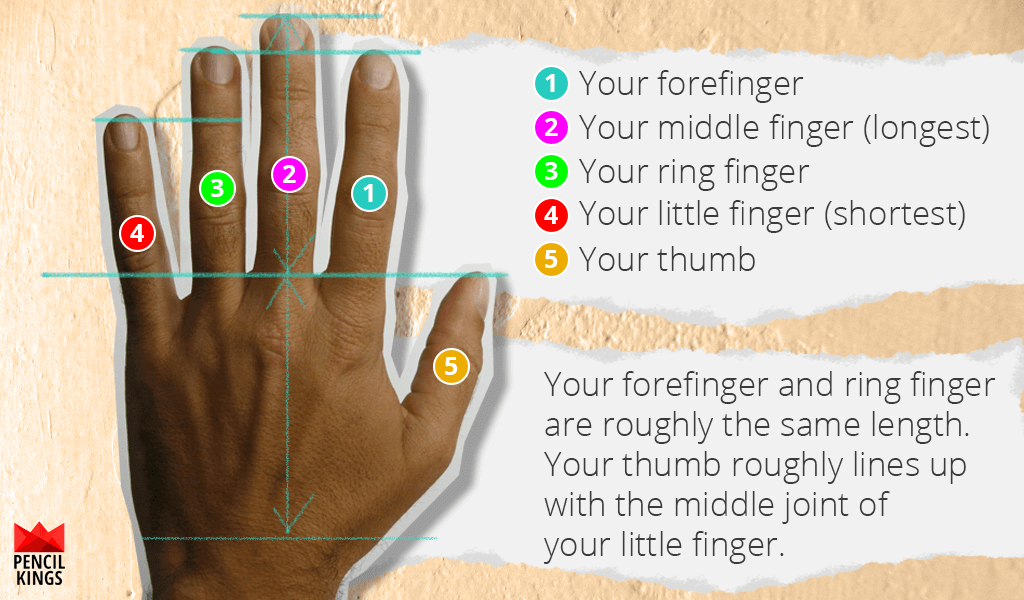
The basic proportions of the hand are as follows:
- The forefinger (1) and the ring finger (3) are roughly the same length
- The middle finger (2) is the longest of all
- The little finger (4) is considerably shorter than the others and falls roughly in line with the third joint in the forefinger
- The thumb (5) is attached much lower down, and roughly lines up with the first joint in your little finger
- The length of the middle finger is roughly the same as the palm or back of your hand
The easiest way to draw the fingers is to see them as a series of cylindrical shapes, like this:
Drawing them this way will help you establish where the joints in the fingers are, and teach you to see the fingers as 3D shapes instead of flat, 2D shapes.
Now look at your own hand. Notice how your fingers aren't completely straight, but bend slightly towards the middle finger? This is a subtle detail, but it'll make a huge difference to how realistic your drawings of hands look.
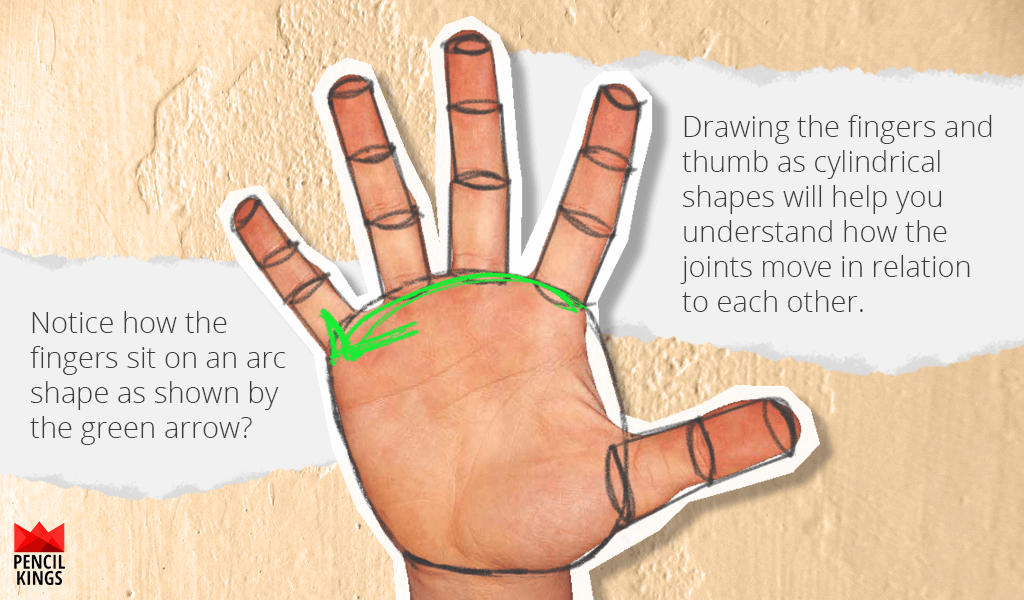
The other important thing to remember here is how the fingers are attached to the palm. Rather than being attached in a straight line, the fingers actually sit on a curved line or arc that goes downwards at the little finger.
You also need to notice how the thumb usually sits at a slight angle when compared to the other fingers. It'll look a little unnatural if you draw it looking face-on like the other fingers.
Using the image above as your reference, practice drawing the hand using these simple shapes. Keep doing it until you start to become more familiar with the structure of the hand and its proportions.
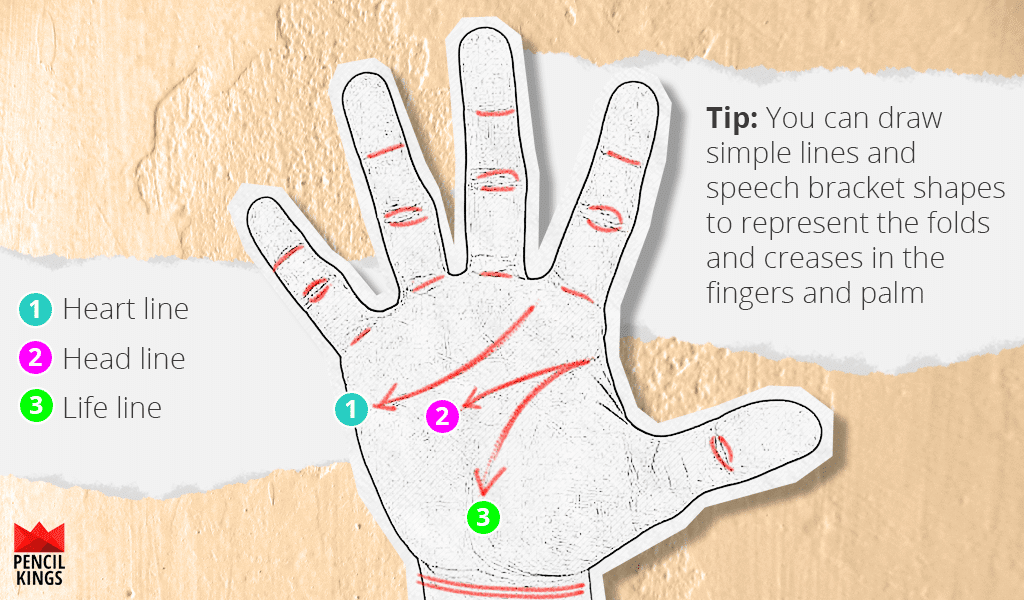
How to Draw Crease Lines on the Palm
To make your hand drawings look more realistic, you'll want to add some crease lines to the palm and fingers.
There are three main lines you need to draw on the palm. These are:
- The heart line (1)
- The head line (2)
- The life line (3)
Take a look at your own hand and see how these lines curve across the surface of the palm. The head line (3) and the life line (3) both start from the same point at the base of the forefinger.
The heart line starts right between the forefinger and middle finger, and then curves down towards the outer edge of the hand. It stops roughly level with the base of your thumb.
If you look at your wrists, you'll also see some creases. These two lines are known as your 'bracelets' and they curve around the cylindrical shape of your wrist.
You can add these if you like, but it's not essential – especially if you're just starting out learning how to draw hands.
Remember how each of your fingers is made up of three bones? Well, it probably won't surprise you to learn the crease lines on your fingers are at the point where each of these bones meet.
Take a look at your own fingers. Notice how the crease lines in the fingers also follow an arc shape like the rest of the hand?
Go ahead and sketch these lines in, like in the illustration above. This is another small detail that will make a big difference to how realistic your drawings look.
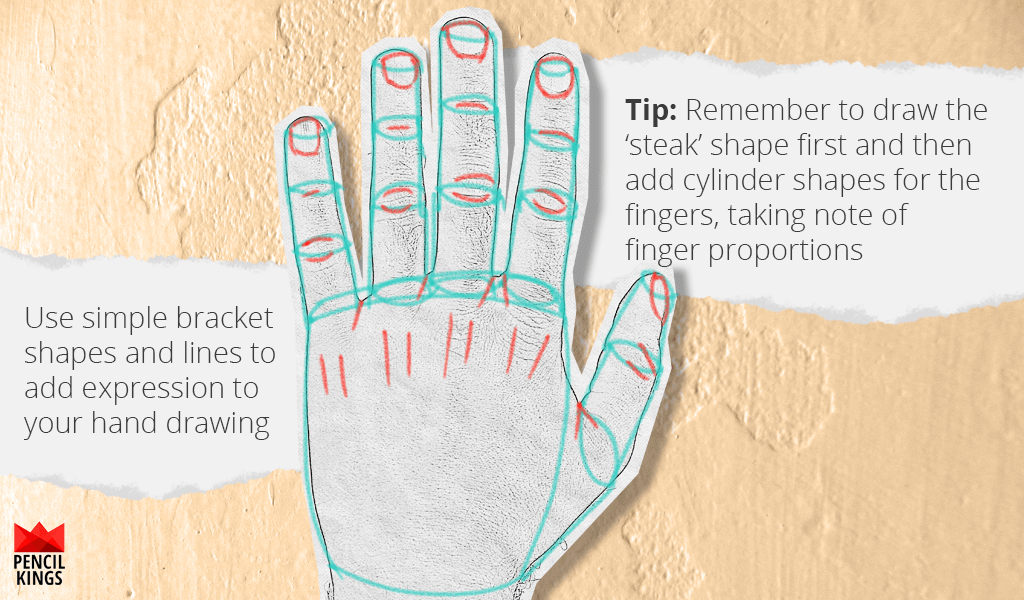
Drawing Hands From the Other Side
Once you've got the hang of drawing hands from the palm side, why not try drawing them from the other side, otherwise known as the back of your hand?
The major differences between the palm and the back of your hand:
- The visible bones of the knuckles
- The different appearance of the skin on the back of the hand
- Creases between the fingers
- Fingernails
Start off by drawing the same basic 'steak' shape for the main part of the hand. Then, taking note of the proportions of the fingers and thumb and the joints between the bones (as in Illustration 4), sketch in those basic cylinder shapes to represent the fingers.
1. Adding the Fingernails
The fingernails are often overlooked when learning how to draw hands, but they're actually a pretty important feature – especially if you're drawing or painting hands close up.
Not only that, but the fingernails can also be used as a useful reference point with regards to the proportions of the hand. For example, the top of the index and ring fingers roughly lines up with the bottom of the fingernail on your middle finger.Pro Tip: Take a good look at your own hand and fingernails. Are they long, short, painted or in need of a little manicuring?
The look of the hands and fingernails says a lot about a person, so this is something you'll want to bear in mind when creating original characters, for example. So how do you get started? Here are the main points to remember:
- The fingernails start about halfway up the top joint of each finger
- Always leave a small gap at each side of the fingernail
- The length of fingernails varies from person to person, ie. males and females
- Fingernails aren't flat – they curve around the surface of the cylinders you drew for the fingers
- If looking at the hand from the top, the fingernail on the thumb will always be seen in a three-quarter view. This is because of the way your thumb is attached to the rest of your hand.
2. Drawing the Knuckles
The knuckles sit at the base of each finger, and also sit on an arc shape. When the hand is relaxed, the knuckles usually aren't too prominent.
A simple way to draw these is to add two straight lines or curved lines like speech brackets at the base of each finger.
3. Drawing the Crease Lines on the Fingers
Just like with drawing the palm side of the hand, the crease lines appear where the joints of the bones in each finger meet.
To draw the main creases in the middle of each finger, just draw two curved lines like speech brackets turned on their side. Notice how these also sit on an arc, rather than a straight line?
If you look at your own hand, you'll also notice some smaller lines at the base of the first bone on each finger. You can sketch these in using some simple curved lines, just like in the illustration.
At the base of each finger, there are some small diagonal crease lines where each finger meets the next.
Now, follow this exact same process for drawing the crease lines on the thumb.
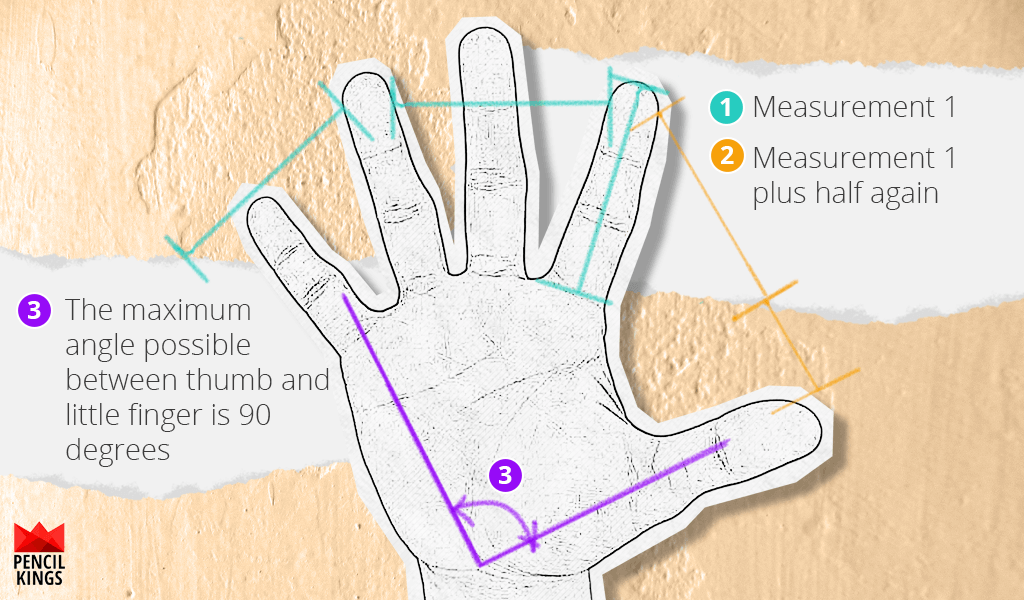
How to Draw Hands: How the Hand and Fingers Move
Now you've learned how to draw the basic shape of the hand from both sides, let's take a look at how the fingers move and how you can draw them more accurately.
First, let's take a look at how your fingers move without bending them.
Look at the top of your hand and fan your fingers out as far as you can, like in the illustration above. Notice how you can only fan them so far?
It's the small details like this that will make a big difference to how realistic your drawings and paintings look.
For this next exercise, we'll use the length of the forefinger as our main reference measurement (measurement 1) like in the illustration.
The main points to remember are:
- The maximum opening between the thumb and forefinger (measurement 2) is about one-and-a-half times the length of the forefinger (measurement 1). So, it's measurement 1 plus half this measurement again.
- The maximum opening between the forefinger and ring finger is the same length as the forefinger (measurement 1)
- The maximum opening between your ring finger and little finger is the same length as the forefinger (measurement 1).Try it yourself by holding your first three fingers together and moving your little finger as far as it will go.You'll notice the little finger isn't extended as far as this in our illustration, but we've drawn the measurement anyway to show you how far it could go.
- The maximum angle possible between your thumb and little finger when fanned out is 90 degrees. Again, try it yourself and see this measurement in action.
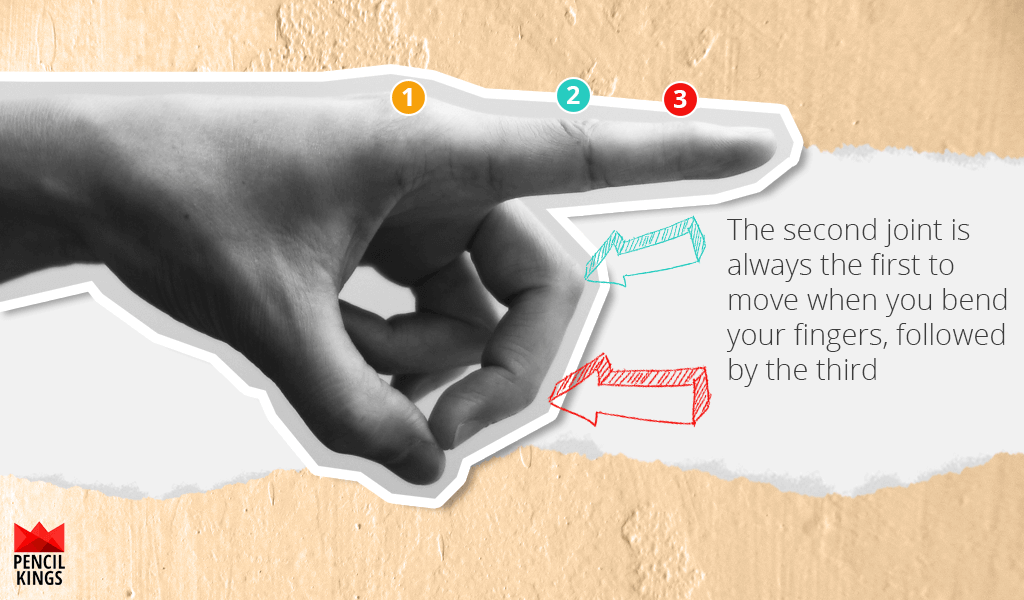
How to Draw the Fingers Bending
Now, let's look at how the fingers move when you bend them.
First, try bending your forefinger from a straight position into a curled position like in the illustration.
Notice how:
- The second joint in your finger is always the first to move
- This is followed by the third joint
- It's almost impossible to move one finger without moving the others slightly
- The thumb is the only part of your hand which can move independently
- The actual proportions of the fingers don't change – only the angles
It's important to remember these small details when drawing hands, because they'll help give your drawings a more realistic feel.
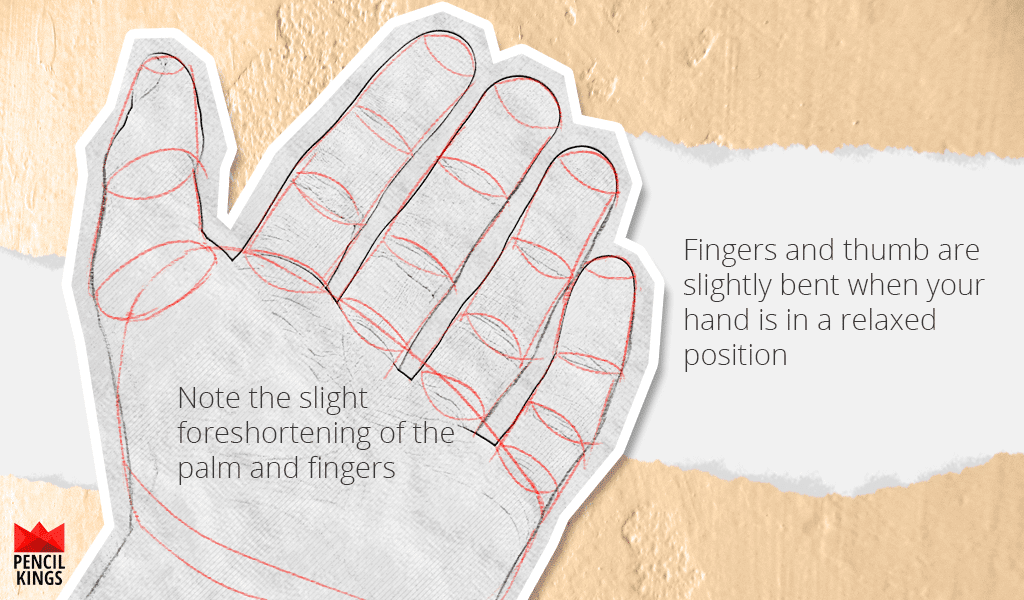
How to Draw the Hand in a Relaxed Position
Because we use our hands all the time, they're rarely in one position for very long.
Whether it's holding a pencil, lifting food and drink to your mouth or even brandishing a sword, there are all kinds of different poses for hands.
Follow along and draw the useful poses in our illustrations. These are a great place to start, because they'll help you understand how the hand moves.
And, once you feel more confident with your hand drawings, you can experiment with other poses if you like.
First, let's take a look at the hand in the relaxed position…
Relax your hand and take a look at what's happening.
Notice how:
- The fingers and thumb are curved or bent slightly.
- Because they're bent, you might notice some slight foreshortening of the fingers. Don't worry about this too much for now – we'll go into foreshortening in more detail in our next blog posts on drawing hands.
- The creases in your fingers don't fall on a straight line – in fact, they fall on an arc shape, like in the illustration.
- You can also see this arc shape in your knuckles and the joints in your fingers.
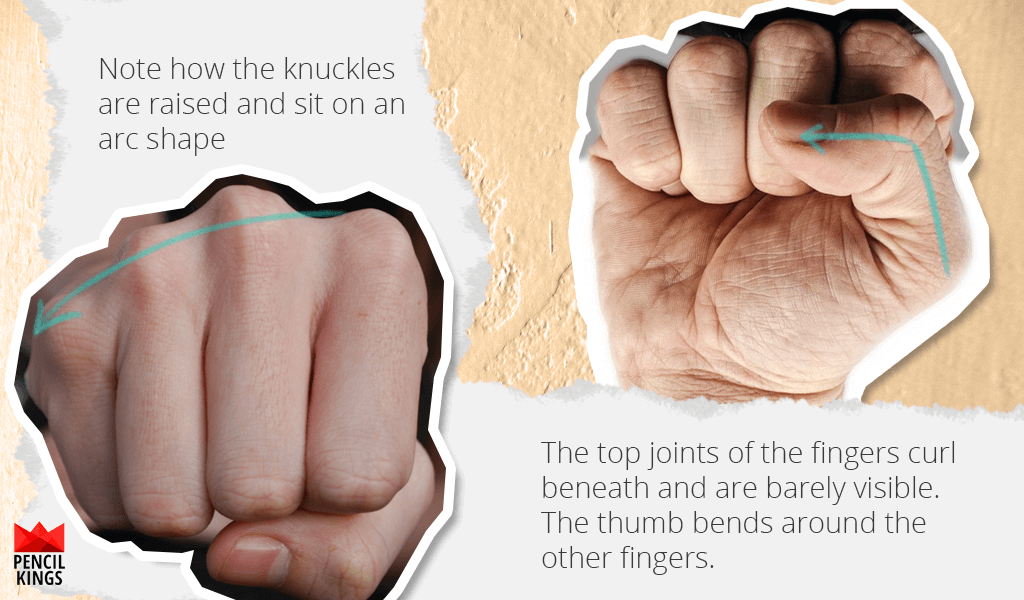
How to Draw a Clenched Fist
Now, let's see how a clenched fist looks…
First, clench your fist and take a look at it from the front.
The main things you'll notice are:
- The top joint of your fingers are barely visible when viewed from this angle
- Your knuckles are raised and sit on an arc shape.
- The thumb is bent around your fingers.
Practice drawing your fist from this angle, and take a look at the image above for guidance.
Now, let's view that same clenched fist from the other side (from below).
The main things to remember here are that:
- The middle joints of your fingers aren't level with each other. Instead, they sit on an upwards angle like in the illustration.
- Your basic 'steak' shape bends in the middle – roughly at the bottom of the thumb.
- The thumb is bent in the middle and in three-quarter view. It roughly lines up with the middle joint of your index finger.
- Depending on how tightly-clenched your fist is, you might not see the tops of the fingers at all. If loosely-clenched, then the top parts of each finger will appear foreshortened.
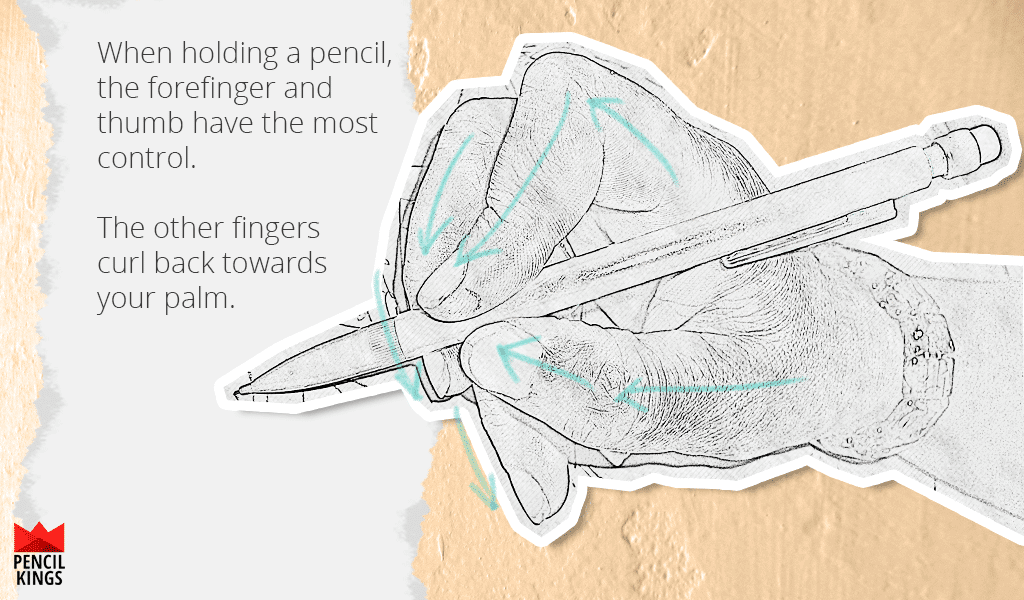
How to Draw a Hand Holding a Pencil
Our fingers can adjust to hold many different things, and it's useful to have an idea of how some of the main poses look.
First, let's see what happens when we hold a pencil…
Pick up a pencil or pen and hold it in your fingers like you were writing or drawing. Notice how your fingers bend and position themselves to ensure a comfortable grip?
The main things to remember here are:
- Your index finger is the one with the most control.
- Your middle, ring, and little fingers curl back towards your palm.
- Your thumb works with your index finger to keep the pencil (or pen) in place.
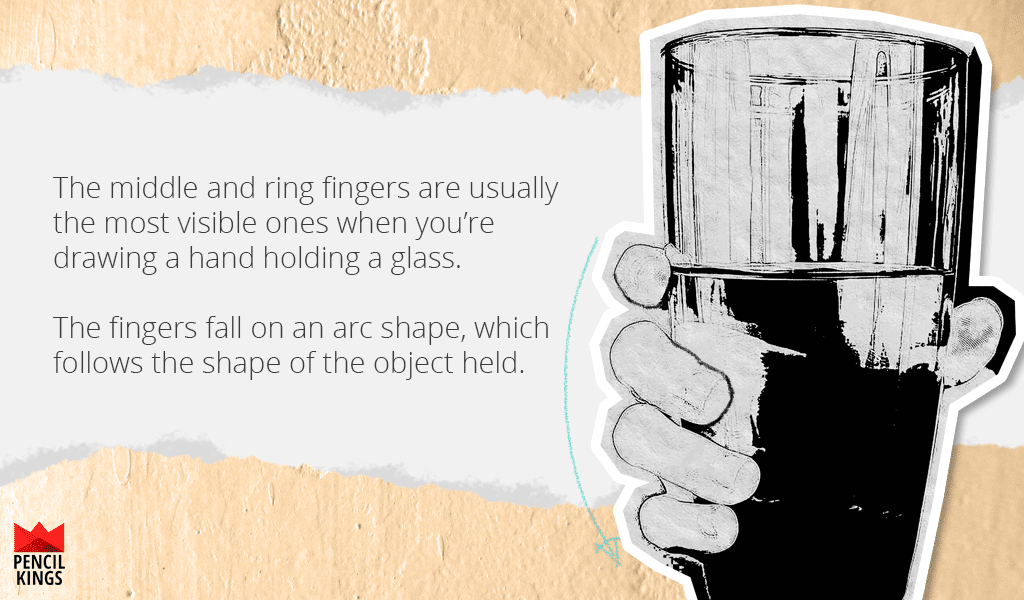
How to Draw a Hand Holding a Glass
Now pick up a glass and look at your hand. Notice how your fingers have automatically bent and formed themselves into the best position for doing this?
You can see how:
- The middle and ring fingers are the most visible ones when wrapped around the glass
- The index finger is less visible and acts as a support
- The thumb is bent slightly on the other side to help hold the glass in place
- The little finger is barely visible at all – you can only really see the tip
- The arc of the fingers follows the shape of the glass you're holding
Of course, there are lots of other hand poses for you to practice. These are just some examples to help get you started and become more familiar with the proportions of the hands and how the fingers move in different situations.
If you're serious about drawing hands, spend 15 minutes a day drawing them in different poses such as the ones in this article.
You'll be surprised at how quickly everything starts to make sense, and how your drawings gradually start to look more realistic.
If you enjoyed this blog post about how to draw hands, why not leave us a comment below?
Drawings of Hands Holding a Pencil
Source: https://www.pencilkings.com/how-to-draw-hands/
0 Response to "Drawings of Hands Holding a Pencil"
Post a Comment